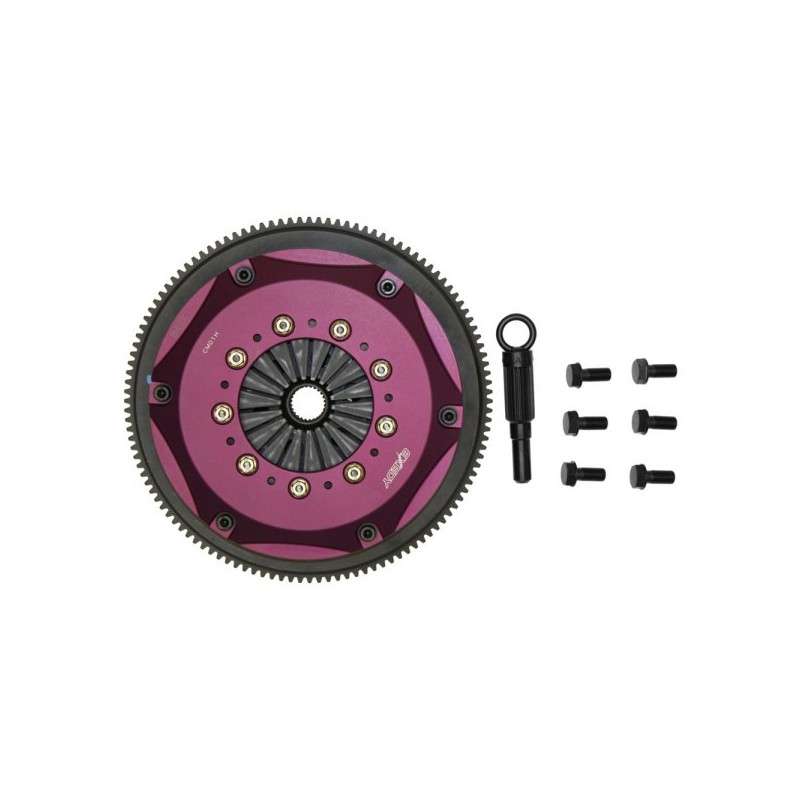No products
Prices are tax included
Product successfully added to your shopping cart
There are 0 items in your cart. There is 1 item in your cart.
R32 EXEDY Stage 5 Racing Clutch Kit
Stage 5 Racing Clutch Kit by EXEDY®. Push Type Clutch. Disc Outer Diameter: 200mm. Input Shaft Spline: 1.16" x 26 Teeth. Disc Center Style: Solid. Clutch Torque Rating: 1659 ft/lbs. Material: Ceramic. Clamp Load: 2653 lbs. Number of Discs: 3. Wheel Torque Rating: 923 lbs/ft. Flywheel Torque Rating: 110 lbs/ft.
These units offer a very consistent operation whether being raced or daily driven. The sprung hub center offers ease of engagement and absorbs many of the driveline vibrations at idle and during acceleration/deceleration. Add more torque capacity to your clutch assembly to handle the extra load of a highly modified engine. These three-plate clutches are designed for extremely high-power drag, road racing and rallying.
Features:
- Triple friction plates for up to 800 lbs.-ft.
- More friction area means a smaller diameter assembly for less inertia.
- Quicker shifts and faster lap times
- All multi-plate clutch kits come with lightweight chromoly flywheel
- Purple anodized forged aluminum cover
- Strap or lug drive, depending on application
- SFI approved for racing
- Spring damper discs or solid discs
- Cerametallic or carbon friction material
- SFI approved
If you've modified your engine and substantially boosted horsepower and torque, a single-plate clutch may simply be inadequate to prevent slippage under full throttle. EXEDY has the solution for engines that deliver as much as 800 lbs.-ft. of torque by doubling the number of plates. The extra friction area also permits using a smaller-diameter assembly for less inertia. The heaviest components of the clutch system are the clutch cover, plates and flywheel. Low-inertia discs allow the transmission to synchronize in a shorter interval of time, eliminating time loss during shift changing while also reducing stress on drivetrain components. The weight of a carbon clutch disc is one third that of a metallic disc.
For most streetable applications, the preferred clutch disc is the cerametallic style with a damper hub. This style of disc will have a consistent feel throughout the day, from the first cold start of the day to a launch from the Christmas Tree after a heat-inducing burnout. The damper hub will help with a smooth launch and improved gearchange feel, as well as eliminate gear rattle moderate speeds. Gear rattle is caused by variations in crankshaft rotational speed, as individual cylinders fire. That in turn makes the gear teeth bounce and rattle against each other as you head on down the road.
A more ambitiously-modified vehicle, used mostly for drag racing, autocrossing or rallying might benefit from the use of a Carbon-D friction disc, Faced with pure carbon fiber, laid one strand at a time and baked at 3600° to cure, carbon fiber has an interesting characteristic: it's coefficient of friction (COF) gets higher as it gets hotter. Unfortunately, it's inconveniently low when at room temperatures, rising to the same COF range as cerametallic friction material when warmed properly. Used in a street vehicle, its inconsistent takeup may be annoying in a daily driver. Carbon fiber is very long-lived in heavy-duty use, however. Carbon-D friction discs have a spring-dampener hub for easy shifting and quiet gears. Carbon-D is equipped with a new dual stage damper, a low-load stage and rapid-acceleration stage, both of which are individually tuned for each car type.
For a dedicated race or track car, Carbon-R friction is preferred. The lack of a dampener hub may mean a fair amount of harshness, vibration and noise may intrude into the cabin or be felt in the gearshift or clutch pedal. The dampened hub, combined with the lighter weight of the whole assembly may make stating up difficult to do without some initial judder. The advantages in shifting speed and torque capacity are the payoff for this lack of refinement.
Due to the inherent properties of the carbon material, EXEDY suggests the proper way to bring the discs up to operating temperature. The correct method is three sequential five second "slips" of the clutch within 30 seconds at low RPM. This will heat the discs so they will hold the specified torque rating.
 Submit a review and get voucher for discount £1, valid for 365 days
Submit a review and get voucher for discount £1, valid for 365 days| Rating: |      |
| Name: | |
| Text: | |
| Add review |



